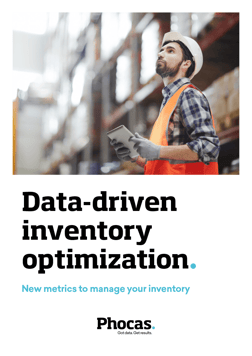What is overstock inventory and how to avoid it?

Lean warehouse management is key to the success of businesses that make, move, or sell products. Conversely, poor inventory control results in overstock problems including theft, expiration, obsolescence, and diminished returns. Overstock means having too much stock in a warehouse that has not sold, which increases storage costs and reduces working capital. To improve the management of your business and keep stock under control, it is worthwhile to manage inventory all in one system, creating a single source of truth for inventory management.
How to avoid overstock
Most companies that manage loads of inventory will practice an inventory management technique. First-in, First-out (FIFO) is popular because it works on the premise that the oldest inventory is shipped first. The FIFO flow concept is a logical one for a business to follow, since selling off the oldest goods first reduces the risk of inventory obsolescence. FIFO requires an organized warehouse, but it helps to plan for the right amount of inventory.
Set minimum and maximum inventory levels
Minimum inventory levels represent a level of stock that is normal to have on hand to prepare you for a variety of situations. Minimum levels are the most important, since maximum levels may be affected by seasonality or promotions. When your inventory stock falls below the predetermined minimum levels, you know it’s time to order more. Ideally, you’ll typically order the quantity that will get you back to minimum levels. The levels will vary by product and are based on how quickly the item sells and how long it takes to get it back in stock. Setting minimum levels requires setting up inventory KPIs in the software, so you understand what these levels should be, and how they might change throughout the year. Once you know what they are, you can set up alerts in the business intelligence solution so you can automate the process of ordering new items and the reorder.
Use a single source of truth for inventory management
Companies need to leverage all inventory data, so this means connecting data from the warehouse via radio frequency scanners or equivalent so the data represents what the warehouse team is picking and pulling and what inventory has arrived. It is necessary to also include all the transactions from the ERP – what has been ordered and what has been paid for, so that anyone across the organization can find and see it. A single source of truth will allow you to be proactive about surplus stock, manage storage space for all your skus and allow your people to understand the nuances of your supply chain so they maintain strong relationships with suppliers.
A suitable inventory management software like Phocas Analytics guarantees efficient inventory management, which helps maintain the balance of the stock and achieve higher profitability. With the right software in place, inventory audits can also be conducted on a regular basis to prevent overstock scenarios and to keep your inventory forecast accurate.
Managing excess inventory
Excess inventory, also known as surplus inventory, refers to products that remain unsold for a long period. This can tie up valuable warehouse space and increase carrying costs. To manage excess inventory effectively, consider the following strategies:
- Liquidation: Selling excess stock at a discounted price to free up warehouse space and improve cash flow.
- Bundling: Combining slow-moving items with popular products to increase sales.
- Donations: Donating excess inventory to charities can provide tax benefits and improve your company's reputation.
Forecasting and inventory turnover
Accurate forecasting is crucial to maintaining optimal inventory levels. By analyzing customer demand, sales trends, and product lifecycles, businesses can predict future inventory needs and avoid overstock situations. Inventory turnover, which measures how often inventory is sold and replaced over a period, is a key metric to monitor. High inventory turnover indicates efficient inventory management and strong sales, while low turnover may suggest overstock issues.
Demand planning and forecasting
Demand planning and forecasting are essential components of effective inventory management. By accurately predicting customer demand, businesses can optimize their inventory levels, reducing both excess stock and stockouts. This helps in lowering inventory costs, improving inventory performance, and ensuring timely restocking. Effective demand forecasting enhances sell-through rates by aligning inventory with actual market demand, thereby maximizing profit margins and improving cash flow. Additionally, it supports better decision-making regarding new products and inventory lifecycle management, ultimately contributing to a healthier bottom line.
Selling excess inventory
Selling excess inventory can be challenging, but it's essential for maintaining healthy profit margins and cash flow. Here are some tips:
- Discount Sales: Offer discounts on excess stock to attract customers and clear out inventory.
- Online Marketplaces: Utilize platforms like eBay or Amazon to reach a broader audience. Specialized inventory liquidators often run their own auction processes as well.
- B2B Sales: Sell excess inventory to other businesses that may have a demand for your products.
Case Study: Caprice Australia
Homewares supplier, Caprice Australia, uses Phocas inventory optimization solutions to ride the fine line between carrying too much inventory and running into out-of-stock issues.
Before Phocas was implemented, Caprice was using ad hoc reports to extract data from its ERP and trying to upload information to Microsoft Excel.
Caprice now provides browser-based access of Phocas to a number of retail customers who are able to check stock availability warehousing for themselves by viewing inventory and purchasing data. This is of enormous benefit to Caprice since it has reduced the number of phone inquiries about stock delivery.
But the benefits, in terms of monitoring sales data and inventory management, are most striking, says Managing Director, Harvey Lewis. “It gives me and my managers the ability to quickly get a handle on information such as slow-moving inventory, margins, sales by customer, and prioritizing of customers and products. We can actually get down to the level of asking why a particular customer hasn’t bought anything from us over a period and go back to see what’s happening.” He estimates overall annual savings to the business of at least A$500,000, which is achieved by reducing the amount of reporting staff and store inventory that wasn't selling.
To find out more about using Phocas inventory management software, download this eBook, How to Avoid the Costs Associated with Over or Understocking.

Empowering businesses with intuitive data analytics, driving informed decisions for growth and profitability. We make people feel good about data.

Using data to plan for the impact of tariffs and further change
Tariffs are here. Whether you're in manufacturing, distribution or retail, it's important to understand how importing from affected countries such as Canada, Mexico or China or chosing local production, can affect your bottom line. We want to encourage you to scenario plan now not retrospectively.
Read more
The best financial KPIs for the distribution industry
Finance professionals in distribution businesses face a persistent challenge. That is to effectively blend operational and financial data to gain a complete picture of company performance. Traditional financial ratios often exist in isolation, making it difficult to assess the broader impact of operational decisions on financial outcomes.
Read more
Key sales KPIs for distribution companies
Managing sales in a distribution business without measuring key performance indicators (KPIs) is like maintaining your home without tools or a schedule. You don’t notice a leak until the damage is severe. Instead of making progress, you waste time searching for the right tools or calling an expert for simple fixes. Without the right KPIs, inefficiencies can go unnoticed, leading to cashflow issues and lost sales.
Read more
Essential KPIs every distribution company executive should measure
For mid-market leaders running a wholesale distribution business, data and business intelligence technology are crucial for monitoring financial and operational performance. However, the real value lies in how your team uses the data insights to influence decision-making.
Read more
Find out how our platform gives you the visibility you need to get more done.
Get your demo today